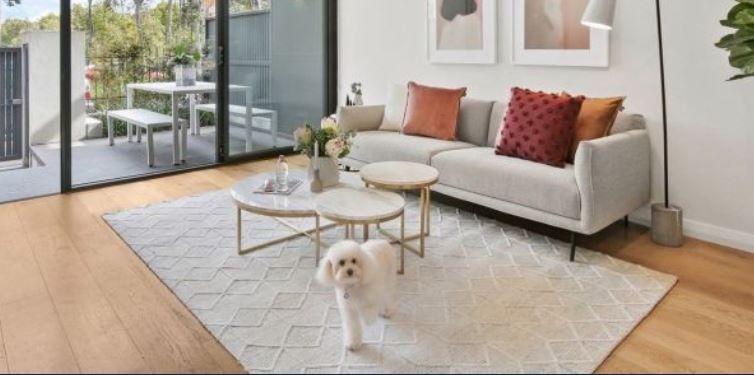How to rent if you have pets: A breakdown of the rules
- By Peter Gordon
- •
- 07 May, 2019

Here's a really useful article for our clients who are landlords and often faced with applications on their property from tenants who have pets. It breaks down the laws state by state.
Finding a good home to rent can be hard enough but when you also have a pet, it can be twice as tricky.
Some landlords are adamant that pets should not be allowed and some apartment bylaws ban all animals – apart from guide dogs – in their buildings.
But with Australia having one of the highest rates of pet ownership in the world, attitudes are changing rapidly.
“I think it’s certainly getting easier for renters with pets,” says John Grima, retail director of the Pet Industry Association of Australia. “Sixty-three per cent of households in Australia have pets and the legislation is changing to accommodate that.
“Many state governments are now promoting the idea that pets should be allowed by landlords, often with additional small bonds being charged in the case of any damage, and many apartments are relaxing their bylaws for suitable pets, like small dogs, cats and reptiles.”
How to convince landlords to allow pets
There’s plenty tenants can do to help press their case to bring their pet along with them when they apply for a new rental, too.
Graphic designer Nic Middenway’s elegant staffy-cross Sammy is well-known around Sydney’s eastern suburbs as she sashays around, carrying one of her favourite handbags from her 20-strong collection.
Friendly, well-behaved and always immaculately accessorised, she’s a firm favourite among landlords. “For me, Sammy is an immovable priority on my wishlist when looking for a home,” says Middenway, 59. “There are places that don’t allow pets but I think, generally, there are more and more now that do.
There’s usually a process you have to go through, with pet application forms to be filled in for apartment buildings and landlords, and rules to abide by. Of course, every dog and pet is different, but sometimes there are some dogs I’d much rather live with than people!”
Middenway helps his application along by providing a CV for seven-year-old Sammy, as well as photographs and a number of references attesting to her character and impeccable manners. Currently renting an apartment in Rushcutters Bay, he says he’s found honesty is always the best policy.
“I’d recommend all pet owners be upfront and honest about your pet; don’t make them out to be anything they’re not,” he says. “And all rules are different from apartment building to building.
“One I know has a weight limit for a pet, which I always think is a little bizarre. A puppy might be quite light, but when it grows up, could be a lot heavier. What do you do then? Do you stop feeding it at some point?”
Often landlords may not list their property as pet-friendly but, when approached by an obviously responsible pet-owner armed with glowing references from previous landlords, will agree to the request. Some apartment buildings that have forbidden pets in the past are also now reviewing their strata rules to allow them in.
“From state to state the laws are different in regards to allowing pets into apartments and rental properties, so it’s always important for pet owners to check what rules could affect them and their beloved pet,” says Nadia Crighton of Pet Insurance Australia.
“Australia has one of the highest incidence of pet ownership in the world, so finding a good rental … is a very important issue facing a lot of hardworking and responsible pet owners. It’s time to see real change in thinking to allow more pet owners access to secure and reliable homes.”
She suggests offering to add an extra clause into a rental agreement that could include cleaning carpets once a year, fixing any possible damage or a pet bond, and developing a pet resume that talks about how well-trained your pet is, along with references from former landlords and neighbours.
Don’t be put off either by a home that’s not advertised as pet-friendly. “Ask, ask, ask,” she recommends. “Many times owners will not advertise that they are pet-friendly when in fact they are – for the right owner. So always ask the question direct.
“And, of course, ensure your pet is not a problem. If you have any behavioural issues such as barking, digging or escaping, call in the experts for help.”
Laws for renting with pets in each state
Rules for renting with pets are different in each state, but it’s worth remembering that individual apartment complexes may have their own bylaws.
Finding a good home to rent can be hard enough but when you also have a pet, it can be twice as tricky.
Some landlords are adamant that pets should not be allowed and some apartment bylaws ban all animals – apart from guide dogs – in their buildings.
But with Australia having one of the highest rates of pet ownership in the world, attitudes are changing rapidly.
“I think it’s certainly getting easier for renters with pets,” says John Grima, retail director of the Pet Industry Association of Australia. “Sixty-three per cent of households in Australia have pets and the legislation is changing to accommodate that.
“Many state governments are now promoting the idea that pets should be allowed by landlords, often with additional small bonds being charged in the case of any damage, and many apartments are relaxing their bylaws for suitable pets, like small dogs, cats and reptiles.”
How to convince landlords to allow pets
There’s plenty tenants can do to help press their case to bring their pet along with them when they apply for a new rental, too.
Graphic designer Nic Middenway’s elegant staffy-cross Sammy is well-known around Sydney’s eastern suburbs as she sashays around, carrying one of her favourite handbags from her 20-strong collection.
Friendly, well-behaved and always immaculately accessorised, she’s a firm favourite among landlords. “For me, Sammy is an immovable priority on my wishlist when looking for a home,” says Middenway, 59. “There are places that don’t allow pets but I think, generally, there are more and more now that do.
- Related: How to choose a good value rental property
- Related: Which pets are best for renters?
- Related: Which features cost renters the most?
“There’s usually a process you have to go through, with pet application forms to be filled in for apartment buildings and landlords, and rules to abide by. Of course, every dog and pet is different, but sometimes there are some dogs I’d much rather live with than people!”
Nic Middenway with his dog Sammy. Middenway uses a pet resume and references when looking for a new home. Photo: Sue WilliamsMiddenway helps his application along by providing a CV for seven-year-old Sammy, as well as photographs and a number of references attesting to her character and impeccable manners. Currently renting an apartment in Rushcutters Bay, he says he’s found honesty is always the best policy.
“I’d recommend all pet owners be upfront and honest about your pet; don’t make them out to be anything they’re not,” he says. “And all rules are different from apartment building to building.
“One I know has a weight limit for a pet, which I always think is a little bizarre. A puppy might be quite light, but when it grows up, could be a lot heavier. What do you do then? Do you stop feeding it at some point?”
Often landlords may not list their property as pet-friendly but, when approached by an obviously responsible pet-owner armed with glowing references from previous landlords, will agree to the request. Some apartment buildings that have forbidden pets in the past are also now reviewing their strata rules to allow them in.
“From state to state the laws are different in regards to allowing pets into apartments and rental properties, so it’s always important for pet owners to check what rules could affect them and their beloved pet,” says Nadia Crighton of Pet Insurance Australia.
“Australia has one of the highest incidence of pet ownership in the world, so finding a good rental … is a very important issue facing a lot of hardworking and responsible pet owners. It’s time to see real change in thinking to allow more pet owners access to secure and reliable homes.”
She suggests offering to add an extra clause into a rental agreement that could include cleaning carpets once a year, fixing any possible damage or a pet bond, and developing a pet resume that talks about how well-trained your pet is, along with references from former landlords and neighbours.
Don’t be put off either by a home that’s not advertised as pet-friendly. “Ask, ask, ask,” she recommends. “Many times owners will not advertise that they are pet-friendly when in fact they are – for the right owner. So always ask the question direct.
“And, of course, ensure your pet is not a problem. If you have any behavioural issues such as barking, digging or escaping, call in the experts for help.”
Laws for renting with pets in each state
Rules for renting with pets are different in each state, but it’s worth remembering that individual apartment complexes may have their own bylaws.
No laws prohibit owning pets, but the standard residential tenancy agreement issued by Fair Trading NSW includes an optional term requiring the landlord’s consent, restrictions on the type of animal, and whether carpets need to be professionally cleaned. Apartment and townhouse complexes have their own bylaws.
Every tenant in Victoria will soon have the right to keep a pet in their rental home after reforms were passed last year in the state’s tenancy rules that will come into effect later this year. Landlords will still need to give permission but it will be much harder to refuse, and they’ll have to prove they have a good case with tenants able to appeal to VCAT.
The state government is also introducing major reforms to the tenancy act by the middle of this year to make pet ownership in rental properties easier. Currently, landlords must give permission and are free to refuse requests, with an estimated one in 10 rentals being pet-friendly. Under the new rules, it will be much more difficult to turn down requests, except in special cases.
South Australia
Landlords have to grant permission for pets to be kept by tenants but an increasing number are now willing to accept animals. There’s no provision for pet bonds, but most landlords will ask for an agreement to be signed enforcing certain rules, such as no noisy barking.
ACT
New laws are being introduced this year by the ACT government to restrict the rights of landlords to ban pets – unless they can demonstrate “reasonable” grounds. The starting point is predicted to be that renters should be allowed to keep pets in their home, while ensuring that any damage is rectified at the end of the lease.
Western Australia
Pet bonds are a usual part of residential tenancy agreements where pets are allowed, and the law states that no more than $260 can be charged to meet the cost of fumigation at the end of the tenancy. The presence of a pet must be stated in the lease, and permission given by the landlord.
Northern Territory
It’s up to the landlord whether pets are allowed in rented premises or not, but tenants can negotiate with their landlords when there’s a no-pet clause in the agreement, or can apply to NTCAT to remove or change the clause on the grounds of it being harsh or unconscionable. Some landlords may include a clause about flea and tick sprays at the end of the term. Pet bonds are illegal.
Tasmania
A tenant can only have a pet at the property if the owner has agreed or if it is in the lease, and the renter has to repair any damage inflicted by the pet at the end of the tenancy. Fumigation will often be included as a term in the lease, with pet bonds not allowed.
Tips for renting with pets
- If a property isn’t advertised as pet-friendly, ask anyway. Landlords may allow pets for the right tenant.
- Prepare a pet resume outlining training and references from past landlords and neighbours.
- Offer to have carpets professionally cleaned once a year.
- Be honest – don’t try and hide pets if they’re not allowed.
- Seek professional help for behavioural problems such as barking or digging.
NEXT FREE LUNCH & LEARN EVENT SYDNEY

| Quiet simply, the Palms is the place to buy! |

Sydneysiders and Melburnians, put aside your equally outstanding flat whites for a moment. Stop bickering about whether great beaches beat cool laneways (they do) and desist from debating whether all baristas require waxed moustaches (ideally).
Because Brisbane is closing in on the title of Australia’s best city, and we must join forces to keep this subtropical upstart in its place.
Time magazine recently named Brisvegas on its “World’s Greatest Places” list, and omitted our cities. It’s a huge shock (and who knew they still published Time magazine?). But they might be onto something.
Time points to the 2032 Olympic and Paralympic Games, which will be hosted in the maroon metropolis. Brisbane will do a fine job, even though it’ll baffle the world when rugby league is added to the schedule and Queensland is allowed to field its own team.
Time’s most radical claim is that Brisbane is worth visiting now, but tourism is surging. Not only did Lin-Manuel Miranda recently drop in to catch Hamilton , but hundreds of Hamilfans flew up to watch his interview with Leigh Sales (presumably unaware that it would subsequently arrive on iView for free).

A leading local agent has appraised each side of these duplex's to be worth $665k on completion and rent for $495 per week. So that is massive potentail instant equity of up to $390K on completion, which is incredibly hard to find.




